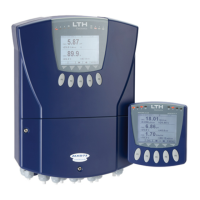Installation
MXD70 pH / Redox
Setup and Operating Guide
- 7 -
Installation
Installation and Choice of pH / Redox Electrodes
The choice of the correct type of pH / Redox electrode, how and where to mount it, so that it has a
representative sample of solution are probably the two most important considerations when installing
a pH / Redox system.
The following criteria are of great importance during selection:
The chemical make up, temperature and the viscosity of the sample.
The use of the correct materials for corrosion resistance.
Position of electrode for robustness and service access.
Ensuring a representative, uncontaminated solution sample.
The following tips might be useful. High temperature samples will restrict your choice to electrodes
with high temperature references, note that low temperatures will also affect the response time of the
electrode. When measuring high viscosity samples it is important that the junction is easy to clean.
Samples with high pH or salt concentrations require electrodes with alkali-resistant membranes.
To ensure correct electrode mounting the following conditions should be observed:
The electrode system can only measure what is in the immediate vicinity of the sensor area of the
probe.
A moderate flow is maintained to provide an “up to date” sample. Excessive flow rates, however, can
cause certain electrodes to rapidly deplete, which will result in inaccurate readings. In this case a
sealed reference is recommended.
Ensure that both the glass electrode and reference are in contact with the sample.
Avoid points where air can be trapped.
Avoid points of high turbulence as air bubbles will affect the measurement.
If the sample has solids present then use a guard or filter to protect the glass electrode. Alternatively
use a flat pH bulb.
The glass electrode contains a liquid, ensure that the probe is mounted so that the internal filling
solution is in contact with the glass bulb.
When a new pH electrode is first fitted or changed it must be calibrated (see page 29). Depending on
the application it may also need periodic re-calibration, the MXD70 series provides an inbuilt count
down timer which will trigger an alarm when calibration interval has expired (see page 36).
SensorTalk Interface
The smart capable version of the MXD70 pH/Redox card is capable of interfacing with the full range of
Broadley James All-Digital Smart pH and Hybrid pH sensors. The Plug-and-Play functionality of the of
the SensorTalk sensors enables “calibrate here use there”. Sensors can be accurately pre-calibrated
away from the operation area with the calibration data stored in the sensor, ready for later use. When
the sensor is connected to the MXD70 series the instrument auto-loads and applies the sensor’s
calibration values.
For the biotech and pharmaceutical applications, ProCount enabled SensorTalk sensors will count all
autoclave/SIP cycles autonomously even if disconnected from the instrument. Once reconnected the
total count is accessible from the instrument.

